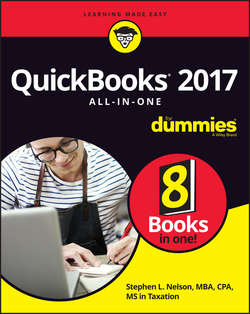Читать книгу QuickBooks 2017 All-In-One For Dummies - Nelson Stephen L. - Страница 10
Book 1
An Accounting Primer
Chapter 2
Double-Entry Bookkeeping
The Fiddle-Faddle Method of Accounting
ОглавлениеMost small businesses – or at least those small businesses whose owners aren’t already trained in accounting – have used the fiddle-faddle method. Take a peek at the financial statements shown in Tables 2-1 and 2-2. If you’ve read or reviewed Book 1, Chapter 1, you may recognize that these financial statements stem from the imaginary hot-dog-stand business. Table 2-1 shows the income statement for the one day a year that the imaginary business operates. Table 2-2 shows the balance sheet at the start of the first day of operation.
TABLE 2-1 A Simple Income Statement for the Hot Dog Stand
TABLE 2-2 A Simple Balance Sheet for the Hot Dog Stand
With the fiddle-faddle method of accounting, you individually calculate each number shown in the financial statement. The sales revenue figure shown in Table 2-1, for example, equals $13,000. The fiddle-faddle method of accounting requires you to somehow come up with this sales revenue number manually. You may be able to come up with this number by remembering each of the sales that you made during the day. Or, if you prepare invoices or sales receipts, you may be able to come up with this number by adding all the individual sales. If you have a cash register, you may also be able to come up with this number by looking at the cash register tape.
Other revenue and expense numbers get calculated in the same crude manner. The $1,000 of rent expense, for example, gets calculated by either remembering what amount you paid for rent or by looking in your checkbook register and finding the check that you wrote for rent.
The balance sheet values get produced in roughly the same way. You can deduce the cash balance of $1,000, for example, by looking at the checkbook or, in a worst-case scenario, the bank statement. You can deduce the inventory balance of $3,000 by adding the individual inventory item values. You can calculate the liability and owner’s equity amounts in similar fashion.
Some of the values shown in an income statement or on a balance sheet get plugged – meaning that they’re calculated by using other numbers from the financial statement. You don’t look up the profit amount in any particular place; instead, you calculate profit by subtracting expenses from revenue. You can also calculate balance sheet values such as total assets, owner’s equity, and total liabilities, of course.
Okay, I admit it: The fiddle-faddle method of accounting works reasonably well for a very small business as long as you have a good checkbook. So for a very small business, you may be able to get away with this crude, piecemeal approach to accounting.
Unfortunately, the fiddle-faddle method suffers the three horrible weaknesses for a firm that doesn’t have super-simple finances:
✓ It’s not systematic enough to be automated. Now, admittedly, you may not care that the fiddle-faddle approach isn’t systematic enough for automation. But this point is an important one: A systematic approach like double-entry bookkeeping can be automated, as you can do with QuickBooks. This automation means that the task of preparing financial statements requires – oh, I don’t know – maybe five mouse clicks. Because the fiddle-faddle approach can’t be automated, every time you want to produce financial statements, you or some poor co-worker must do an enormous amount of work to collect the numbers and all the raw data necessary to produce information like that shown in Table 2-1 and Table 2-2. In reality, of course, with more complicated financial statements, someone does much, much more work.
✓ It’s very easy to lose details. This sounds abstract, but let me give you a good, concrete example. If you look at Table 2-1, you see that the hot dog stand incurs only three operating expenses: rent, wages, and supplies. If you know the operating expense categories that the business incurs, it’s fairly easy to look through the check register and find the check or checks that pay rent, for example. You can use a similar approach with the wages and supplies expenses. But what if you also have an advertising expense category, a business license expense, or some other easy-to-forget category? If you forget a category, you miss expenses. If you forget that you spent money advertising and, thereby, forget to tally your advertising expenses, that whole category of operating expense gets omitted from your income statement.
✓ It doesn’t allow rigorous error checking. This business about error checking may seem to be nitpicky, but error checking is important with accounting and bookkeeping systems. With all the numbers and transactions floating around, errors easily creep into the system. I discuss error checking more later in this chapter, but let me give you an example of the sort of error checking an accounting system can (and should) perform. Take a look at the example of the sales transaction. If you sell an item for $1,000, you can actually check that amount by comparing it with your record of what the customer paid. This makes sense, right? If you sell me an item for $1,000, you should be able to compare that $1,000 sale with the amount of cash that I pay you. A $1,000 sale to me should correspond to a $1,000 cash payment from me. The fiddle-faddle method can’t make these comparisons, but double-entry bookkeeping can.
You see where I am now, right? I’ve admitted that you can construct financial statements by using the fiddle-faddle method. But I hope I’ve also convinced you that the fiddle-faddle method suffers some really debilitating weaknesses. I’m talking about something as important as how you can best manage the financial affairs of your business. These weaknesses indicate that you need a better tool. Specifically, you need double-entry bookkeeping, which I discuss next.
